
The #MeToo movement has swept the nation - the world- in recent years, helping survivors of sexual violence finally have a voice. It offers a safe place to talk about your experiences and get help.
Over the course of this movement, it's had me thinking back to an anonymous survey I did about 5 years ago. I asked my class to see what fellow students felt about and knew about Sexual Violence. I've compiled a lot of the research and data from that time into this article. The participants of the study totaled at 23 and consisted of answering a 10 question survey. 5 of the questions were yes, no or unsure replies. the other 5 consisted of agree or disagree statements. These questions were later refined and broken down into just 7 questions with more choices for answers, which yielded similar results from the first survey.
But before I get into the astounding data, lets first get a feel for what Sexual Violence is. To help wrap our brains around the topic, I've divided a lot of the data into 2 categories of sexual violence: sexual assault and sexual harassment.
Now, before we get into the nitty gritty, I want to give an ample warning to those who might be sensitive to this kind of material. There will be discussion about sexual violence, which includes assault, harassment, rape and other topics of the like. If you feel this material may be triggering to you, I implore you to stop here and look for other more suitable material for yourself. Thank you.
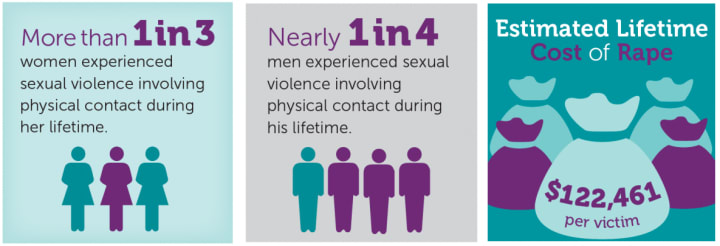
FACT VS MYTH
MYTH: Sexual harassment is rare.
FACT: Sexual harassment is extremely widespread. It touches the lives of 40 to 60 percent of working women, and similar proportions of female students in colleges and universities.
MYTH: The seriousness of sexual harassment has been exaggerated; most so-called harassment is really trivial and harmless flirtation.
FACT: Sexual harassment can be devastating. Studies indicate that most harassment has nothing to do with "flirtation" or sincere sexual or social interest. Rather, it is offensive, often frightening and insulting to women. Research shows that women are often forced to leave school or jobs to avoid harassment; may experiences serious psychological and health-related problems.
MYTH: Many women make up and report stories of sexual harassment to get back at their employers or others who have angered them.
FACT: Research shows that less than one percent of complaints are false. Women rarely file false complaints. Women rarely file complaints even when they are justified in doing so.
MYTH: Women who are sexually harassed generally provoke harassment by the way they look, dress and behave.
FACT: Harassment does not occur because women dress provocatively or initiate sexual activity in the hope of getting promoted and advancing their careers. Studies have found that victims of sexual harassment vary in physical appearance, type of dress, age, and behavior. The only thing they have in common is that over 99% of them are female.
MYTH: If you ignore harassment, it will go away.
FACT: It will not. Research has shown that simply ignoring the behavior is ineffective; harassers generally will not stop on their own. Ignoring such behavior may even be seen as agreement or encouragement.
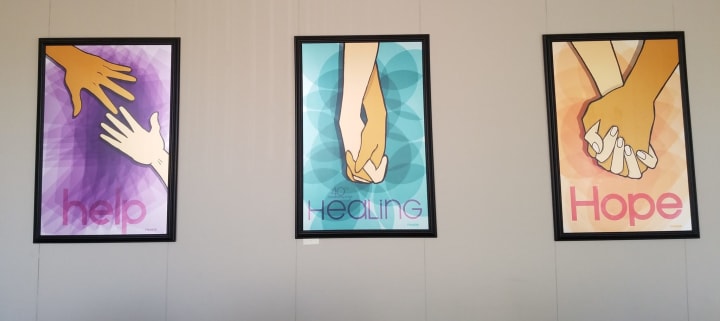
THE DEFINITION
So, what the hell is sexual harassment? To sum it up, it's unwanted sexual advances. But there's a lot more that goes into it than simply just that.
Unwelcome sexual advances, requests for sexual favors, and other verbal or physical conduct of a sexual nature constitute sexual harassment when:
- Submission to such conduct is made either explicitly or implicitly a term or condition of an individual's employment;
- submission to or rejection of such conduct by an individual is used as the basis for employment decisions affecting such individual; or
- such conduct has the purpose or effect of substantial interfering with an individual's work performance or creating an intimidating, hostile or offensive work environment."
Okay, so we've got the idea of what sexual harassment is, but how is that different from sexual assault? Or sexual violence for that matter?
The term sexual assault refers to sexual contact or behavior that occurs without explicit consent of the victim. Some forms of sexual assault include:
- Attempted rape
- Fondling or unwanted sexual touching
- Forcing a victim to perform sexual acts, such as oral sex or penetrating the perpetrator’s body
- Penetration of the victim’s body, also known as rape
As you can see, the definitions are similar. They cover two separate sides of the same coin. Sexual harassment can turn into sexual assault in the blink of an eye, but there doesn't need to be a presence of sexual harassment for a sexual assault to occur. Both are very traumatizing to the victims. Both of these definitions make up the encompassing definition of sexual violence.
So how many people are affected by sexual violence?
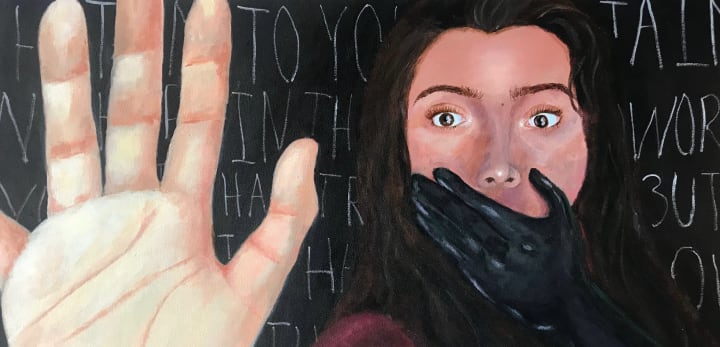
MORE FACTS
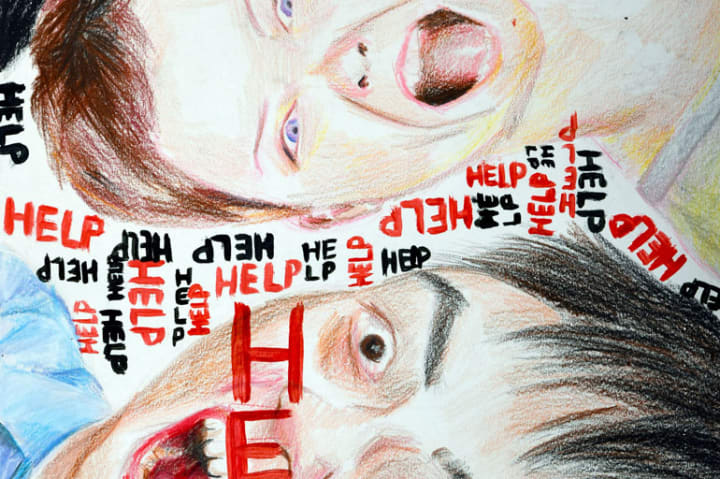
WHAT CAUSES SEXUAL ASSAULT/HARASSMENT TO OCCUR?
I could sum this answer up with one word: Power. But, because such a serious question deserves a more in-depth answer, here we go.
Social and political changes in recent years have changed the power in relationships. Some men have feelt threatened by the career advancement of women and people of color, or are uncomfortable with women's newfound independence and assertiveness at home and or at work. Of course sexual assault and harassment have been around for centuries, but it's integral to understanding why it happens, especially now that we've begun to further seek justice for these acts.
On the other side of the coin are the victims of these sexual cases. Prevalence of marital stress and divorce in our society means that some men and women come to work in a state of emotional distress that could make them vulnerable to sexual harassment. The key here to finding a victim is vulnerability. There are many varying factors to being 'vulnerable' it could be situational (stress, death of a family member, divorce) It could be psychological (autism, depression, anxiety, Alzheimer's) or physical (disabilities, chronic conditions, lack of choice in mobility). It can be your age (young children or the elderly, who either can't speak or don't understand what's happening to them).
Even just being a woman can put you into a category of vulnerability. Sexual assault and harassment happen to men, this I'm not denying. But the statistics show that women are much more likely to be harassed, assaulted, abused and raped.
The bottom line is: the victim is never at fault for these things that happen to them. It's caused by the need for power, to feel control over another human being.
Warning: the link below may be additionally triggering for those who've suffered from Sexual Violence.
PSYCHOLOGICAL TOLL
- Lose confidence and self-esteem
- Drop in job/school performance
- Embarrassment
- Isolation/Depression
- Being Fearful
- Feeling of Powerlessness, hopelessness, or being out of control
- Having self-doubt
- Shame and guilt; self-blame
- Difficulty concentrating
- Feeling violated and/or betrayed
- Difficulties with remembering appointments or gaging time
- Loss of trust in people
- Suicidal thoughts or attempts
These are some but not all of the psychological tolls one can have. They're not exclusive of one another. Someone whose experienced sexual violence can feel all of these. While others could feel none on this list, but others not mentioned.

PHYSICAL TOLL
- Anxiety and/or panic attacks
- Traumatic stress; post-traumatic stress disorder (PTSD)
- Sleeplessness and/or nightmares
- Retaliation from the harasser or colleagues/friends of the harasser
- Stomach problems; gastrointestinal disorders
- Eating disorders
- Increased blood pressure
- Problems with sex (sexual dysfunction) or intimacy
- Fatigue or loss of motivation
- Headaches
- Withdrawal and isolation

RISK FACTORS FOR SEXUAL ASSAULT
These are some common risk factors associated with sexual assault.
- Alcohol use
- Sorority/fraternity membership
- Numerous sexual partners
- freshman/sophomore status -The first two years of college are the highest risk years. And the first few months of the school year are the highest risk time of year.
- Weekends midnight to 6am - More than half of sexual harassments take place during this time.
- Off-campus parties
These 'risk factors' stated above are strictly taken from data and surveys done over the years. It pinpoints where and when a large portion of sexual violence takes place. It in no way is blaming the victims for being or participating in activities that make them 'more at risk' than others. Perhaps when in these certain public places (such as a sorority or at an off campus party) you could watch out for suspicious activity and speak up or call the police if you think someone might be in trouble.
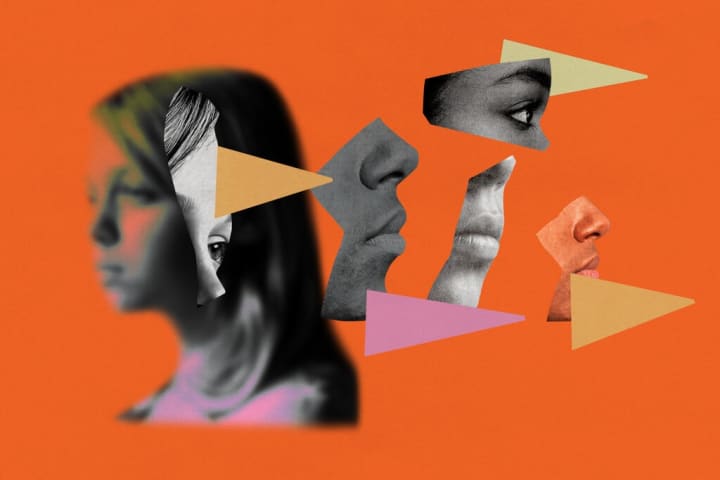
RISK FACTORS FOR SEXUAL HARASSMENT
- characteristics of the work environment (e.g., sexist attitudes among co-workers, unprofessional work environment, skewed sex ratios in the workplace, knowledge of grievance procedures for sexual harassment incidents)
- The risk factors most strongly associated with sexual harassment were an unprofessional environment in the workplace, sexist atmosphere, and lack of knowledge about the organization's formal grievance procedures.
The truth is, most acts of sexual violence will be committed by someone the victim knows and often times trusts. This could be a partner, a family member or even a coworker.
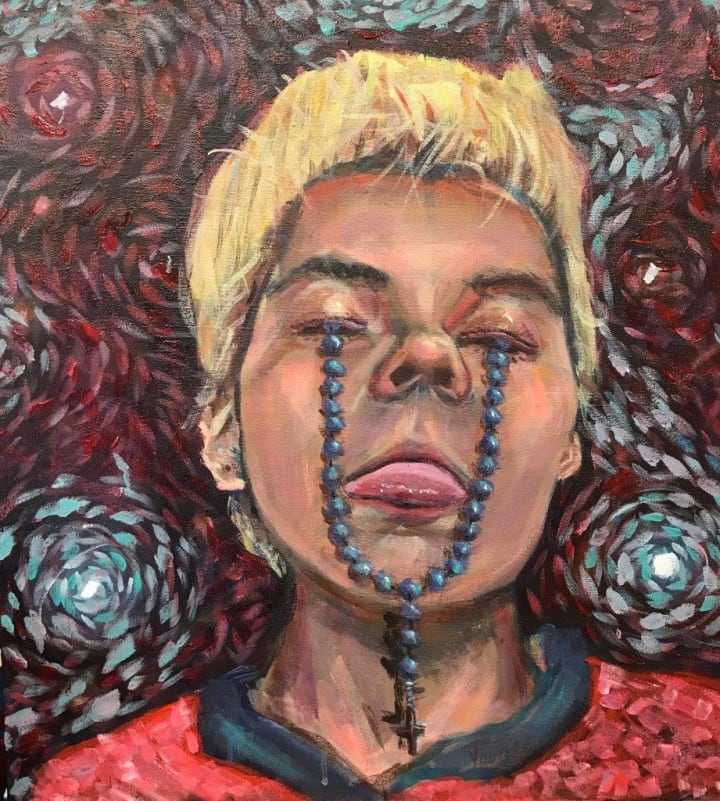
SEXUAL VIOLENCE AGAINST TRANSGENDERED PEOPLE
Violence against trans or gender queer people has been on the rise in recent years, and with that so has sexual violence. It's estimated that 66% of trans survivors experience sexual assault, which is often coupled with physical assault or abuse.
Rates are even higher for those who fall under the categories of Trans youth, Trans POC, and Trans disabled.
Fifteen percent of transgender individuals report being sexually assaulted while in police custody or jail, which more than doubles (32 percent) for African-American transgender people. Five to nine percent of transgender survivors were sexually assaulted by police officers. Another 10 percent were assaulted by health care professionals.
Some cases of sexual violence against a transgender individual can be considered a hate crime. There was a case many years ago where a man was dating a woman, and upon finding out she was trans, he murdered her.
Sadly, I was unable to dig up the specific case I was thinking of, because when I typed "man murders woman after finding out she's transgender" I found so many other similar cases, I just couldn't sift through them all.
The ugly truth about this is that Transgendered people are one of the more likely people to die from these escalated sexually Violent hate crimes.
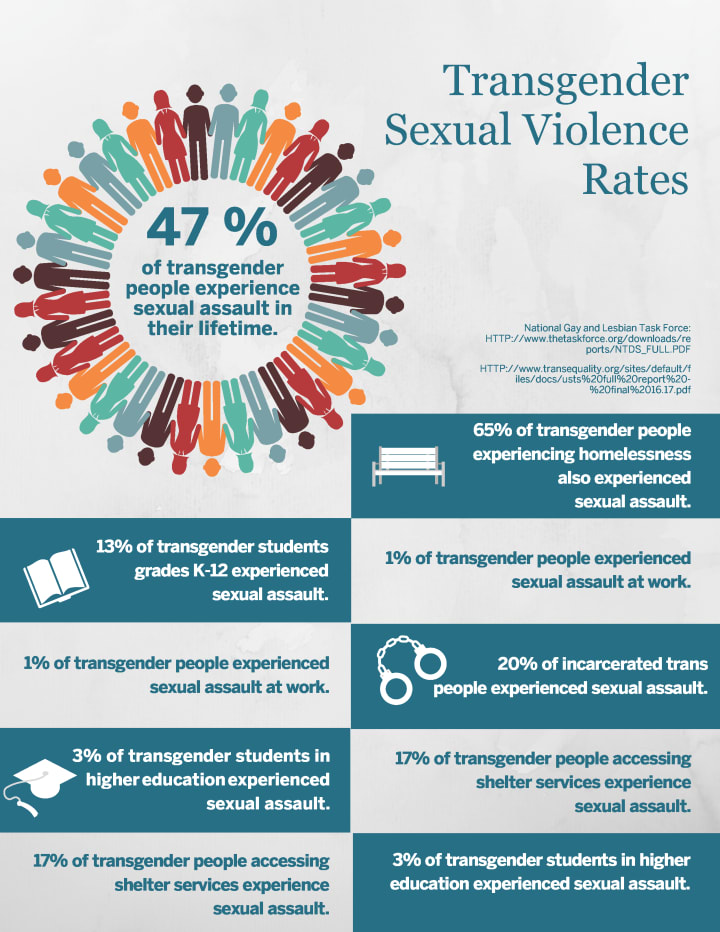
In the NCAVP 2009 report on hate violence, 50 percent of people who died in violent hate crimes against lesbian, gay, bisexual, transgender, and queer (LGBTQ) people were transgender women; the other half were male, many of whom were gender non-conforming.7 Sexual assault and/or genital mutilation before or after their murders was a frequent occurrence.
One in two transgender individuals are sexually abused or assaulted at some point in their lives - ovc.gov
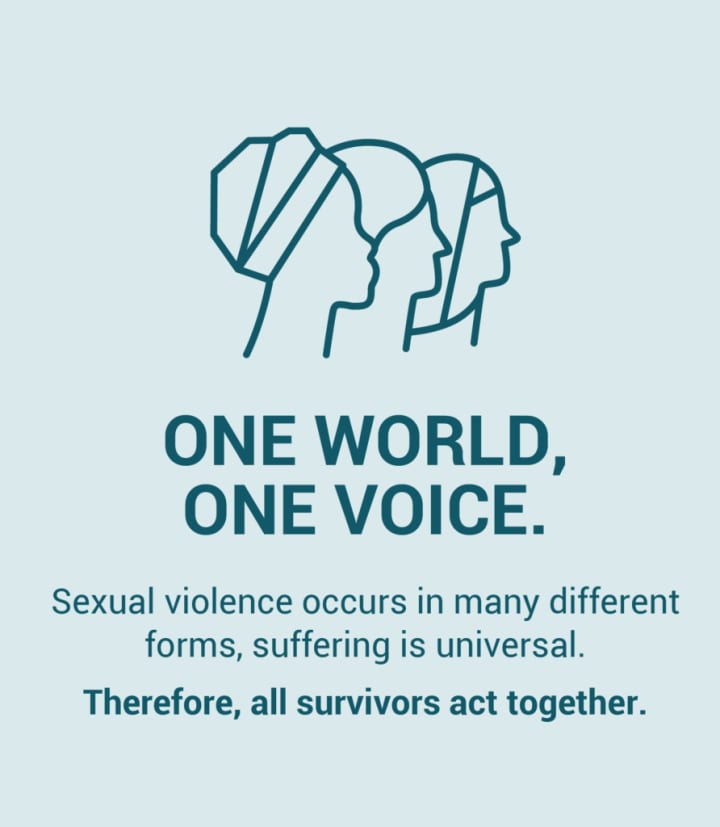
WHY WE DON'T REPORT
Many of the reasons that we don't report have to do with the physical and psychological toll being subjected to sexual violence can have on you. Of course, every survivor has their own unique reason for not reporting.
However, many survivors decide to not report abuse to law enforcement. Some reasons for not reporting abuse are fear-based, and some are more personal. Some survivors simply do not believe there will be any benefit to reporting abuse.
- Dordulian Law Group
In recent years, as we've looked more into these issues, we've realized that many women take months to years to process what's happened to them. In some cases, by the time they come to realize what has happened to them, the statute of limitations has expired. It's an often jarring experience, and those who are younger (like children and young teens) can actually bury that memory for many years, because of the defense mechanisms our brain has.
These of course, are just temporary fixes our brain makes so we can get through the situation. Eventually, the memories return. For some women and men who were exposed to sexual violence at a child, it doesn't resurface until they're 30- even 40 years old.
Some don't report for fear of not being taken seriously, some from retaliation. Some fear reliving those moments, if the case were ever to reach a trial. Others, while not so much fearing the re-telling, fear facing their abusers again.
Even if an individual decides not to report, or the statute of limitations has expired, it's highly suggested that you seek therapy, so you can talk through the trauma and begin to heal and learn healthy ways to deal with the trauma.
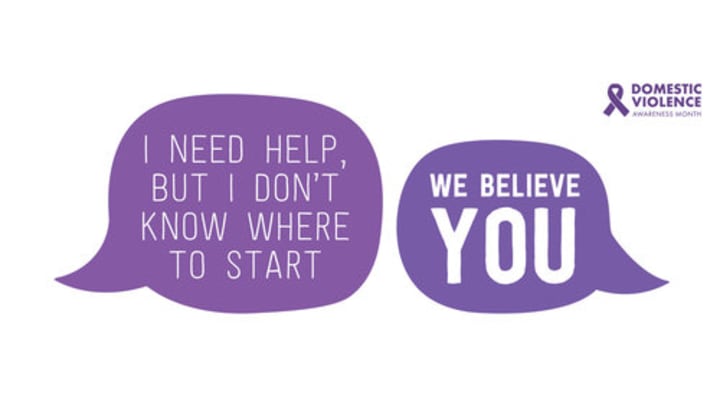
THE CLASS DATA
The class I asked these questions to ranged from ages 14-19 and was a pool sample of 23 students. I'd just like to keep that in mind, while we take a look at these astounding findings, as well as the fact that this took place about 4 years ago when I collected the data.
QUESTION 1- Have you or somebody you know ever been sexually harassed?
Yes 14 No 6 Unsure 3
this means 60% of those surveyed answered yes. 26% said no, and 13% were unsure.
QUESTION 2- How often do you hear or see sexual harassment?
Never 2 All the time 3 Unsure 7 Hardly ever 11
47% answered "hardly ever" while 13% said all the time. never and unsure added up to almost 40%
QUESTION 3- Have you ever stood up for someone whose being harassed?
Yes 15 No 8
65% said they've stood up for someone whose being harassed. This is an amazing number and really___________
QUESTION 4- I believe the student body at this school has the power to do something about sexual harassment.
Agree 18 Disagree 5
78% believed that the school we attended had the power to do something about sexual harassment.
QUESTION 5- Sexual harassment occurs within our community
Agree 23 Disagree 0
100% agreed that sexual harassment does occur within the community.
QUESTION 6- I have personally witnessed, perpetrated or been a target of sexual harassment.
Agree 7 Disagree 16
Almost 70% disagreed, which was honestly quite a relief.
QUESTION 7- I believe that adults at this school have the power to do something about sexual harassment.
Agree 17 Disagree 6
73% agreed that the adults around the school had the power to 'do something' about sexual harassment.
I think that looking at these stats from almost five years ago makes me hopeful. I think that if my class felt they could trust their institutions to take action, perhaps they'd feel safer to come to them if something were to happen to them. I think that perhaps these questions could of been a lot to digest, and the format didn't leave enough room to include some people's true answers.
I learned a lot from doing this survey and research and think that more than ever, it's important to educate everyone- not just your kids- on sexual violence, and how to prevent it.
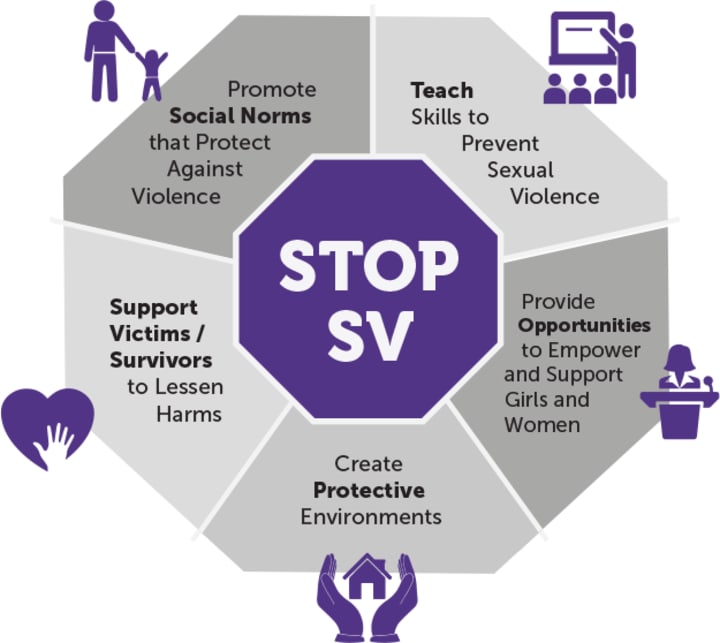
PREVENTION
First of all, I'd like to start by saying that those being pursued by others in these acts of sexual harassment and assault, they're not to blame. They're not the ones who need to work on 'prevention.' Instead, parents and communities need to pull together. To educate early about the signs, harms, and dangers of sexual violence.
Personally, I think a start to that has to be through the age appropriate education of these topics.
In recent years, the UN proposed a worldwide guideline on how Sexual Reproductive Education should be taught in schools, with different age appropriate topics for age groups starting from first grade all the way to 12th (they base it off of ages in the official report, not grades). From a young age, this plan would teach about body autonomy and consent. Even as young as Kindergarten, children around the world would be taught in a way that they could understand. Some examples of how it can be taught to young children are like so:
Example:
"Can I please hug you?"
"No thank you, I don't want to be hugged right now."
"Okay."
Even just this simple lesson teaches so much; consent, the right to your own body and respecting other peoples decisions even if it's not the answer you want to hear. The proposed guideline also covers topics like being compassionate and understanding to all kinds of people: your partner, those with HIV, young people who are also parents, and those who are LGBTQIA+.
One of the goals of this plan was to reach children with this education before they become sexually active. It's a great read, and if you're not into reading the whole thing, here's a 4 page synopsis.
Many schools and universities also provide a 'Sexual Violence Prevention Training' course. At my college, it was required to be completed before we were able to attend classes. I felt safer, and more at ease knowing my school was taking steps to educate their students, and by doing so, increasing their chances of living a safe life on and off campus.
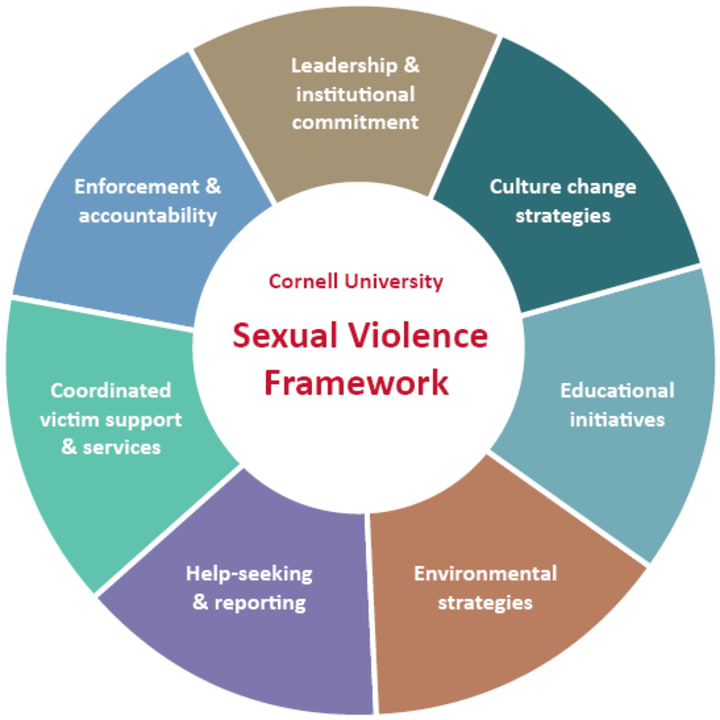
There are many ways to prevent these events, but none of the ones that work include telling the victim to be more vigilant. None of them blame the victim or tell them they 'should of done this instead.'
So talk. Talk to your kids about body autonomy, about consent. Talk to your friends about your boundaries, and have conversations with your partners about continuing consent throughout your relationship while keeping an open line of communication. Look for if your company has a sexual harassment training course in place.
It can be hard, but making it a conversation is what's going to reduce these rates, reduce these stories. These are things that the #MeToo movement has begun to turn the gears towards. Which is why I admire this movement so much.
SOURCES
http://counseling.uoregon.edu/TopicsResources/StudentSelf-Help/SexualAssaultAbuseHarassment/SexualHarassmentMyths.aspx
http://www.nij.gov/topics/crime/rape-sexual-violence/campus/pages/increased-risk.aspx
http://www.hg.org/sexual-harassment-law.html
http://www.shepherd.edu/safweb/SUIVRC/sh/sh_impact.html
http://www.cdc.gov/ViolencePrevention/pdf/sv-datasheet-a.pdf
https://harass.stanford.edu/be-informed/effects-sexual-harassment
https://metoomvmt.org/
https://www.dlawgroup.com/reasons-people-do-not-report-sexual-abuse/
https://www.rainn.org/articles/sexual-assault
https://ovc.ojp.gov/sites/g/files/xyckuh226/files/pubs/forge/sexual_numbers.html
https://www.sacasa.org/facts/
OTHER GREAT ARTICLES EXPLORING SEXUAL VIOLENCE
About the Creator
QuirkyMin
Aspiring writer, sharing articles of personal interest as well as original short stories.
https://linktr.ee/quirky.min




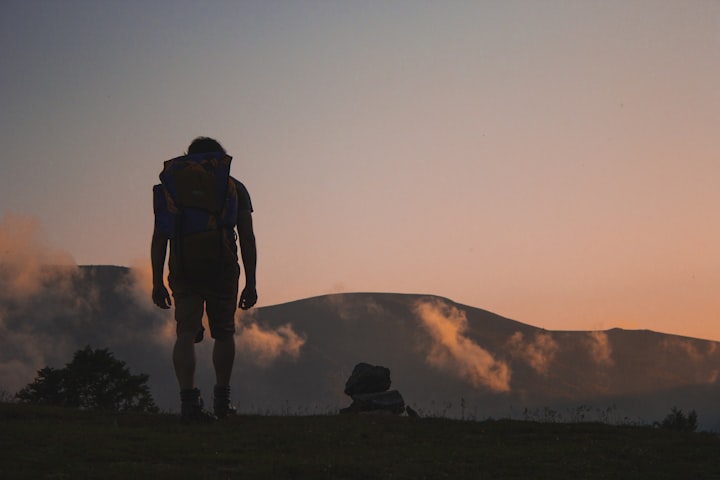

Comments
There are no comments for this story
Be the first to respond and start the conversation.